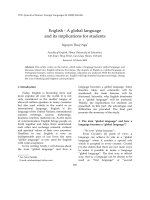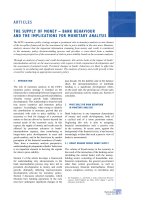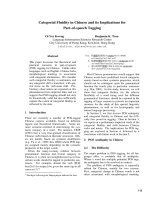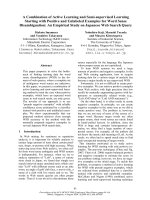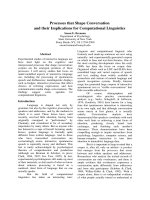three essays exploring consumers' relationships with brands and the implications for brand equity
Bạn đang xem bản rút gọn của tài liệu. Xem và tải ngay bản đầy đủ của tài liệu tại đây (1.68 MB, 186 trang )
THREE ESSAYS EXPLORING CONSUMERS’
RELATIONSHIPS WITH BRANDS AND THE
IMPLICATIONS FOR BRAND EQUITY
DISSERTATION
Presented in Partial Fulfillment of the Requirements for
the Degree Doctor of Philosophy in the Graduate
School of The Ohio State University
By
Randle D. Raggio, M.B.A., M.A.
* * * * *
The Ohio State University
2006
Dissertation Committee:
Approved by
Professor Robert P. Leone, Adviser
Professor Neeli M. Bendapudi ______________________________________
Professor Patricia M. West Adviser
Business Administration Graduate Program
Copyright by
Randle D. Raggio
2006
ii
ABSTRACT
During the past 15 years, brand equity has been a priority topic for both
practitioners and academics. Despite the attention it has received during this period, no
consistent measure of brand equity has been adopted. In Chapter 2, I propose a new
framework for conceptualizing brand equity that distinguishes between brand equity,
conceived of as an intrapersonal construct that moderates the impact of marketing
activities, and brand value, which is the sale or replacement value of a brand. Such a
distinction is important because, from a managerial perspective, the ultimate goal of
brand equity research should be to understand how to leverage equity to create value.
In Chapter 3, I develop a measure of brand equity that is consistent with the
framework introduced in the previous chapter, but is based on an empirical procedure that
utilizes the loadings produced by an unconstrained factor analysis model that is applied to
binary consumer response data collected by the Procter & Gamble Company (P&G) for
brands from four product categories and five countries (17 total markets).
P&G’s survey consists of hundreds of questions, which give a general idea of how
favorable consumers' beliefs are about brands. What these questions do not provide is
any insight concerning how consumers arrive at those beliefs, important information that
iii
brand managers were lacking. This chapter introduces an empirical procedure to identify
which sources consumers use to develop their beliefs about brands, i.e., high-level brand
or detailed attribute sources, and the implications for brand management. From these
sources, I then develop a measure of brand equity based on consumers' use of the high-
level brand source and show that a significantly smaller number of questions can produce
a measure of brand equity that correlates highly with that produced by P&G's current
system. The benefit to marketing management is the implication that by using the
approach described in this paper, other companies also can better understand where their
consumers’ brand beliefs come from, and now can develop a measure of brand equity
that does not require a large complex instrument.
In Chapter 4, I seek to understand the strategic implications of the mental sources
of information consumers draw from to develop their beliefs about the benefits that
brands deliver, as described in Chapter 3. The general hypothesis is that the level of
information that consumers currently use to develop their brand beliefs (high-level brand
information or detailed attribute information) will moderate the impact of new
information, such that a strategic advantage exists for brands when consumers currently
use one of the sources instead of the other. The results from Chapter 3 demonstrated that
the high-level brand source is more closely related to a measure of brand equity. The
question remains whether the outcomes that are supposed to accrue to a brand with high
equity (especially those of greater loyalty and less vulnerability) empirically can be
linked with either the high-level or detailed attribute source. Chapter 4 describes an
iv
experiment to test whether consumers’ current use of the high-level brand source or
detailed attribute source is associated with less vulnerability to new (negative)
information. What this study finds is that when subjects receive negative brand-level
information second, it has a greater negative impact on overall brand evaluation if the
initial information they possess about the brand is also at a brand level. Since the second
brand-level information does not specifically contradict the initial attribute-level
information, consumers would be left to determine the extent to which they will let the
new non-performance related information impact their overall brand evaluations.
On the contrary, when consumers are faced with negative brand-level information
that directly contradicts existing brand-level information stored in memory, it is
reasonable that this new information would be assimilated with the old, and the overall
evaluation fall.
The results do not support a general prophylactic effect of the brand source, but
are consistent with existing brand theory and provide a strong foundation for future
research.
v
ACKNOWLEDGMENTS
I wish to thank my family, Noel, Jenna and Jack, for their willingness to join me
on this journey. The completion of this dissertation is a testament to their faithful love,
support, and encouragement. Words are inadequate to express the love and appreciation I
feel for them.
For all of their teaching, mentoring, encouragement, and support, I wish to thank
Neeli Bendapudi and Pat West, and extend a special note of thanks to Michael Browne
for his feedback and guidance through the development of the RAMONA statistical
procedure.
Bob Leone deserves special recognition as an adviser, mentor, guide, and
collaborator. His constant encouragement sustained me in times of doubt and his
willingness to share his wisdom and experience has helped me navigate the often tortuous
course. I have learned much more than marketing or research from him, and my future
colleagues and students will benefit from his influence.
I am forever indebted to Jim Morrison, who, as a graduate teaching assistant at the
University of Southern Mississippi, ignited within me a passion for reading and writing,
vi
and to David Rados, who, as a professor at Vanderbilt University, helped me discover a
love of marketing. Without the influence of either of these, this journey never would
have begun.
Many thanks to those students who preceded me into the program and guided the
way: Yancy Edwards, Sam Min, Tim Gilbride, Priyali Rajagopal, and Ling-Jing Kao; and
to those who joined in the journey along the way: Jenny Klett, Sandeep Rao, and Jeff
Dotson, with special thanks to Nicole Votolato and Doug Bosse for their friendship,
encouragement, collaboration and support.
The data for Chapter 3 came from the Procter and Gamble Company through the
generous efforts of Andreas Onnen and John Myers; I am grateful for their insights and
guidance during the development and implementation of the procedure.
vii
VITA
February 7, 1969 Born – New Orleans, Louisiana
1991 B.S.B.A., Management Information Systems,
University of Southern Mississippi
1991-1994 Information Systems Consultant,
Andersen Consulting, New Orleans, Louisiana
1994-1995 Information Systems Consultant,
Raggio & Associates, Mandeville, Louisiana
1997 M.B.A., Vanderbilt University
1996-1997 Marketing Manager,
Kidpower, Brentwood, Tennessee
1997-1999 Marketing Director,
Kidpower, Brentwood, Tennessee
1999-2002 Instructor, Belmont University College of Business
Administration, Nashville, Tennessee
2000-2002 Director of Graduate Programs,
The Jack C. Massey Graduate School of Business,
Belmont University, Nashville, Tennessee
2002-present Graduate Teaching and Research Associate,
Department of Marketing and Logistics,
The Ohio State University
FIELDS OF STUDY
Major Field: Business Administration
Minor Field: Quantitative Psychology
viii
TABLE OF CONTENTS
Page
Abstract……………………………………………………………………………… ii
Acknowledgments…………………………………………………………………… v
Vita……………………………………………………………………………………. vii
List of Tables …………………………………………………………………………. xi
List of Figures…………………………………………………………………………. xiii
Chapters:
1. Introduction……………………………………………………………………. 1
2. Implications of the Theoretical Separation of Brand Equity and Brand Value… 3
2.1 Introduction……………………………………………………………… 3
2.2 Why Did Researchers Gravitate to Outcomes? 6
2.3 What’s Wrong With Using Outcome Measures? 8
2.3.1 Not specific to a particular market, usage occasion or group
of consumers……………………………………………….…. 11
2.3.2 Ignores non-customers and future potential………………… 12
2.3.3 Makes Incorrect Comparisons………………………………… 14
2.3.4 Assumes same goals/objectives across firms……………… 17
2.3.5 Puts emphasis on short-term effects that may be “vulnerable”. 18
2.4 Non-Outcome Measures Also Present Theoretical Problems…………. 19
2.5 Additional Considerations…………………………………………… 21
2.6 Developing a New Theory of Brand Equity and Brand Value…….…… 22
2.6.1 Brand Equity vs. Brand Value…………………………………. 22
2.6.2 Brand Value……………………………………………………. 27
2.6.3 Brand Equity…………………………………………………… 40
2.6.3.1 Brand Equity Defined……………………………… 43
2.6.3.2 Thresholds……………………………………………. 48
ix
2.6.3.3 Private Label…………………………………………. 50
2.7 The Proposed Brand Equity Conceptual Model ……… 52
2.8 The Model………………………………………………………………. 56
2.9 Conclusion and Future Research Opportunities ……………………… 61
3. Producing a Measure of Brand Equity by Decomposing Brand-Benefit Beliefs
Into Brand and Attribute Sources…………………………………………… 66
3.1 Introduction………………………………………………………………. 66
3.2 Sources of Consumers’ Brand-Benefit Beliefs…………………………… 70
3.2.1 Sources of Brand Ratings Conceptualization………………… 71
3.2.2 Prior Theoretical Literature……………………………………… 74
3.3 The Model………………………………………………………… 78
3.3.1 Ratings Scales Versus Check Boxes……………………. 82
3.3.2 Simulation Studies………………………………………. 83
3.3.3 Model Reliability and Stability…………………………. 92
3.3.4 Estimation……………………………………………… 99
3.4 Data……………………………………………………………………… 100
3.5 Results………………………………………………………………… 101
3.5.1 Scenarios………………………………………………………… 102
3.5.2 Case Examples………………………………………………… 105
3.6 BrandÆBenefit Loading Relationship With Equity……………………… 110
3.7 Discussion………………………………………………………………… 115
3.7.1 Summary of Findings and Discussion…………………………. 115
3.7.2 Conclusions………………………………………………….…. 117
3.7.3 Further Research……………………………………………… 119
4. The Moderating Effect of Source of Prior Information on the Impact of New
Information…………………………………………………………………… 122
4.1 Overview…………………………………………………………………. 122
4.2 Background and Rationale……………………………………………… 123
4.3 Pre-Test Procedures……………………………………………………… 125
4.3.1. Research Design……………………………………………… 125
4.3.2 Sample…………………………………………………………. 128
4.3.3 Measurement/Instrumentation…………………………………. 128
4.3.4 Data Analysis………………………………………………… 129
x
4.4 Final Survey Procedures …………………………………………………. 134
4.4.1. Research Design……………………………………………… 134
4.4.2 Sample………………………………………………………… 135
4.4.3 Measurement/Instrumentation………………………………… 135
4.4.4 Data Analysis…………………………………………………. 136
4.5 Discussion……………………………………………………………… 140
Appendices:
A. Questionnaire: Pre-Test
(Initial Attribute Information) ……………………….……………………… 143
B. Questionnaire: Pre-Test
(New Attribute Information) …………….…………………………………… 149
C. Questionnaire: Final Survey………………………………………………… 156
Bibliography………………………………………………………………………… 164
xi
LIST OF TABLES
Table 2.1: MSI’s (1999) Criteria for an Ideal Measure of Brand Equity… ……… 5
Table 2.2: Potential Outcomes of Brand Equity Identified in the Literature………. 9
Table 2.3: Brand Equity vs. Brand Value Propositions……………………………. 27
Table 2.4: Brand Value Propositions……………………………………………… 39
Table 2.5: Situations in which Brand Equity May Become Activated…………… 47
Table 2.6: Brand Equity Propositions…………………………………………… 59
Table 3.1: Data Description……………………………………………………… 77
Table 3.2: Comparison of constrained vs. unconstrained results…………………… 81
Table 3.3: Simulated Data Population Values…………………………………… 84
Table 3.4: Results of Simulation Studies………………………………………… 87
Table 3.5: Data Description and Model Results Across Markets………………… 96
Table 3.6: Results of Random Starts Investigation……………………………… 97
Table 3.7: Relationship between calculated Brand Index (BCI) and Equity
Across Categories and Segments………… …………………………. 114
Table 4.1: Candidate “Initial Information” Statements…………………………… 126
Table 4.2: Candidate “Negative Information” Statements……………………… 127
Table 4.3: Pre-test results Across Questions……………………………………… 131
Table 4.4: Statement pairings for final survey (i.e., four cells of the experiment)…133
xii
Table 4.5: Descriptive statistics from final survey………………………………. 136
Table 4.6: Planned contrasts of initial brand evaluation…………………………. 137
Table 4.7: Planned contrasts of final brand evaluations………………………… 138
xiii
LIST OF FIGURES
Figure 2.1: Levels of Brand Value………………………………… ……………. 29
Figure 2.2: Brand Value Over Time……………………………………………… 33
Figure 2.3: The Impact of ADA Approval on Crest’s Market Share (from Leone
1987)………………………………………………………………… 35
Figure 2.4. Brand Equity as a Moderator of Marketing Activity Æ Consumer
Action Link………………….………………………………………… 44
Figure 2.5: General Brand Equity Framework…………………………………… 55
Figure 2.6: Vulnerable Sources of Brand Equity………………………………… 58
Figure 3.1: Sample Decomposition Across Different Attributes………………… 73
Figure 3.2: Path Diagram of Conceptual Model…………………………………… 78
Figure 3.3: Latent continuous representation results in binary observation……… 89
Figure 3.4: A large number of checks for a particular benefit increases the value
of α and causes the distribution to shift from curve a to curve b… …. 91
Figure 3.5: Decomposition for consumers who differ in the degree to which they
care about “Brand” in their selection of offerings in Paper Products 1
category…………………………………………………………… …. 103
Figure 3.6: Decomposition for “Store Brand” in U.S. Paper Products 2 category 104
Figure 3.7: Correlation between average brandÆbenefit loading and P&G’s
equity measure across countries in the Oral Care category…… ….…. 106
Figure 3.8: Correlation between average brandÆbenefit loading and P&G’s
equity measure across countries in the Paper Products 2 category… 107
xiv
Figure 3.9: Correlation between average brandÆbenefit loading and P&G’s equity
measure across countries in the Paper Products 1 category……… …… 108
Figure 3.10: Results of brand beliefs decomposition by purchase behavior
for leading brand in U.K. Skin Care market……………………………… 110
Figure 3.11: Results of Brand Index correlation with P&G equity measure
in Oral Care category across countries…………………………………… 113
Figure 4.1: Marginal means of initial and new brand evaluation for subjects who
received attribute information second………………………….……… 139
Figure 4.2: Marginal means of initial and new brand evaluation for subjects who
received brand information second………………………………….… 140
1
CHAPTER 1
INTRODUCTION
I became fascinated with brand equity while working as the marketing director for
Kidpower, the toy company that produced the Funnoodle, America’s number one-selling
summer toy for six years in a row in the late 1990’s and early 2000’s. Unfortunately,
while nearly everyone recognized the long, ubiquitous, brightly colored foam pool
noodles, very few could recall the brand name. This deficit did not affect sales, as we
continuously captured more than 90% of the market as the sole provider of pool noodles
to Wal Mart, Target, Kmart, Toys R Us, Sam’s and Costco. But it did spark a question
about the role and value of a strong brand, especially as we attempted to extend the brand
into other pool products and related categories.
This dissertation will explore brand equity from a variety of perspectives. In
Chapter 2, I propose a new conceptual framework for thinking about brand equity,
specifically what it is and how it should be measured. This chapter also serves as a
general literature review. Chapter 3 investigates brand equity from an empirical
perspective, offering a model to decompose consumer brand beliefs into components that
can be used to produce a measure of brand equity. Chapter 4 extends the empirical work
of Chapter 3 with an experiment to determine if the components identified as associated
with brand equity produce effects that have been attributed to brand equity. From a
research perspective, this dissertation, with its conceptual, empirical and experimental
chapters, indicates the development of a comprehensive set of tools that can be applied to
address the substantive issue at hand, and suggests the multi-faceted approach that I hope
to employ as I continue to develop this research stream.
I am indebted to the researchers that have worked to develop the brand equity
concept and its measurement over the past 15 years. It is only through their efforts that I
have been able to question why brand equity is so hard to measure and begin to develop
the theory that underlies the framework that I am introducing. I hope to ignite a lively
and productive debate that will move our discipline toward a more general agreement on
what brand equity is, how it is best measured and how it relates to other managerially-
relevant concepts. This dissertation is my initial contribution to that effort.
2
CHAPTER 2
IMPLICATIONS OF THE THEORETICAL SEPARATION
OF BRAND EQUITY AND BRAND VALUE
“…remarkably few academic researchers have addressed
brand equity measurement per se. This may be partly due to
disagreement about whether equity should be measured from
the consumer or the firm perspective….”
(Ailawadi, Lehmann and Neslin 2003, p.1).
2.1 Introduction
3
Brand equity is an important topic for marketing, strategy, economics, finance, and
accounting, and because strong brands are associated with more efficient marketing
activities (Smith and Park 1992; Srivastava and Shocker 1991), brand equity continues to
be one of the most researched areas in marketing. However, researchers recently have
proposed that it is even more important for managers to measure, track, and increase
customer equity (Blattberg and Deighton 1996; Rust, Lemon, and Zeithaml 2004; Rust,
Zeithaml, and Lemon 2000, 2004), that is, the total discounted lifetime values summed
over the firm’s current and potential customers (Rust, Lemon, and Zeithaml 2004). As
Rust, Lemon, and Zeithaml (2004, p. 110) state, “In recent years, customer lifetime value
(CLV) and its implications have received increasing attention…. For example, brand
equity, a fundamentally product-centered concept, has been challenged by the customer-
centered concept of customer equity.” This shift has opened a debate among researchers
about the relationship and importance of brand equity as defined by Farquhar (1989),
Aaker (1991, 1996), and Keller (1993) versus recent—and exploding—work that relies
on measuring CLV (e.g., Blattberg, Getz, and Thomas 2001; Gupta, Lehmann, and Stuart
2004; Reinartz and Kumar 2000; Reinartz, Thomas, and Kumar 2005; Rust, Lemon, and
Narayandas 2004; Venkatesan and Kumar 2004).
In response to this debate, I suggest that brand equity represents the customer-
focused portion of a larger framework that includes both brand and customer equity, as
well as brand value. One need look no further than the Journal of Marketing to observe
how this area has recently evolved; its two most recent award-winning articles have dealt
successively with brand equity (Ailawadi, Lehmann, and Neslin 2003) and customer
equity (Rust, Lemon, and Zeithaml 2004). A comprehensive framework is needed to
reconcile the two views.
1
I provide such a framework by explicating the relationship
between two separate, but related constructs: brand equity, which has a consumer-based
perspective, and brand value, which has a company-based perspective, and of which
customer equity is a component. This chapter will begin by focusing on the more
comprehensive concepts of brand equity and brand value, then will both suggest how
customer equity fits into a new framework and contribute to the understanding of existing
customer equity models (e.g., Rust, Lemon, and Zeithaml 2004a).
In 1999, leading researchers and practitioners participated in a workshop on brand
equity metrics (MSI 1999) and developed the 10 criteria for an ideal measure of brand
equity listed in Table 2.1.
4
1
Participants at AMA’s 2005 Winter Educator’s Conference, during a special session on customer equity,
also highlighted the current debate and called for a comprehensive framework.
1. Grounded in theory.
2. Complete, i.e., encompassing all the facets of brand equity, yet distinct from
other concepts.
3. Diagnostic, i.e., able to flag downturns or improvements in the brand’s value
and provide insights into the reasons for the change.
4. Able to capture future potential in terms of future revenue stream and brand
extendibility.
5. Objective, so that different people computing the measure would obtain the
same value.
6. Based on readily available data, so that it can be monitored on a regular basis
for multiple brands in multiple product categories.
7. A single number to enable easy tracking and communication.
8. Intuitive and credible to senior management.
9. Robust, reliable, and stable over time, yet able to reflect real changes in brand
health.
10. Validated against other equity measures and constructs that are theoretically
associated with brand equity.
Table 2.1: MSI’s (1999) Criteria for an Ideal Measure of Brand Equity.
While no single measure is likely to meet all these criteria, I believe that the
primary obstacle preventing further development of managerially useful brand equity
measures and tools is the lack of a theoretical foundation for the concept of brand equity,
as well as a clear distinction between brand equity and brand value. The purpose of this
chapter is to provide such a theoretical foundation that can be used to evaluate not only
the MSI desiderata, but also current and future brand equity and customer equity
research. Ultimately, I hope that this foundation will allow researchers to develop a more
robust measure of brand equity and provide more effective managerial tools for
maximizing both brand equity and brand value.
5
Many researchers have attempted to measure brand equity, but have succeeded in
defining and measuring only outcomes of brand equity; that is, only benefits that are
hypothesized to accrue to brands that possess brand equity. Though definitions of brand
equity (e.g., Keller 1993) allude to conditions (associations) within individuals that lead
to (1) biased processing of information, (2) persistent attitudes or beliefs that are (3)
resistant to change, and (4) behaviors that are influenced by those beliefs (c.f., Farquhar
1989; Keller 2003b), measures suggested in the literature are one or two stages removed
from the individual: either focusing on brand-level or firm-level outcomes.
In some cases, it is possible that outcome measures may be useful in showing that
brand equity exists (or does not exist) for a brand. However, in most cases, relying on
outcome measures is not appropriate. While outcome measures contribute to brand
value, they can be either inaccurate or misleading indicators of the presence or absence of
brand equity. If this is true, then why have researchers used outcomes as a measure of
brand equity, and what are the problems that exist when using outcomes?
2.2 Why Did Researchers Gravitate to Outcomes?
By focusing on outcomes of brand equity, rather than the construct itself
(Ailawadi, Lehmann and Neslin 2003), the majority of prior research has missed the
opportunity to advance our understanding of brand equity. It is easy to understand why
researchers frequently use outcome measures. First, outcome measures are used because
they are readily available to firms and researchers, since they exist in the data that
6
companies generate as part of normal operations. Researchers do not have to go through
any substantial effort to collect data or to validate a new measure. Along with being so
readily available, outcome measures have the appeal of offering what appear to be
universal measures of brand equity, but in reality, as will be demonstrated with examples
in Section 2.3, outcome measures are not appropriate in many cases. This is because
there can be a significant amount of slippage between brand equity and the proposed
outcomes (c.f, Fennell and Allenby 2003; Verhoef 2003). “Slippage” refers to the fact
that there is not a consistent one-to-one mapping between brand equity and outcomes.
Second, the researchers investigating brand equity have usually been concerned
with strategic implications and shareholder value, which are important to managers.
Marketing strategy researchers have been able to use more aggregate measures to
investigate the causes of sustained competitive advantage and the financial implications
of marketing activities in order to establish their findings. In the same way that behavior
is sometimes used as a proxy for attitude, outcome measures have served as a proxy for
brand equity. Unfortunately, this has resulted in proposed measures of brand equity that
do not capture the construct, but are actually incomplete measures of brand value. The
distinction between brand equity and brand value is important to the theoretical
framework that I will introduce, and this distinction will be discussed in Section 2.6.
Finally, some researchers may resist going “upstream” to investigate brand equity,
even though the source of brand equity ultimately resides within the hearts and minds of
consumers (Ambler 1997). Investigating intrapersonal measures may be seen as the
domain of psychology and consumer behavior, so strategy researchers might shy away
7
from using theory and findings from this domain, or feel that the measures might not be
easy to link back to strategic decision making, or not as “intuitive and credible to senior
management” (MSI 1999 #8) as are outcome measures.
The above may explain why outcome measures have been used. However, the
literature lacks a comprehensive review of the consequences of relying on outcome
measures as a proxy for brand equity. The next section will discuss some of the
theoretical and empirical issues associated with using outcomes.
2.3 What’s Wrong With Using Outcome Measures?
Outcome measures are subject to three general criticisms. First, outcome measures
have alternative explanations (Keller 1993; Agarwal and Rao 1996; Amine 1998). Most
studies propose measures that only measure potential outcomes of brand equity, but since
the behavioral process is not defined, multiple alternative explanations can always be
generated. Table 2.2 lists 34 outcome measures of brand equity that have been proposed
in the literature, but it is important to note that Agarwal and Rao (1996) demonstrate that
outcome measures are highly correlated with each other and basically provide the same
information.
Second, outcome measures lack diagnostic ability (Ailawadi, Lehmann and Neslin
2003). While an outcome measure may indicate where a brand is at a point in time, it
8
gives no indication as to how it got there, or how to change (improve) the measure in the
future. Further, it is possible that prescriptions designed to boost outcome measures may
actually undermine brand equity.
Primary External Outcomes
1
Price premium
Market Share
Revenue premium
Perceived quality
Satisfaction
More positively weighted attributes
Value (in use, or value proposition)
Brand name awareness
Unaided recall
Share of mind
Esteem
Brand liking
Brand image
Brand associations (positive, unique, strong)
Brand Personality
Meaning of the brand
Brand loyalty (repurchase rates)
Brand preference
Purchase intention
Index of past purchases
Willingness to continue to purchase brand
Switching costs
Secondary External Outcomes
2
Organizational associations
Distribution coverage
Stock price
Replacement value of the brand
Market value of the brand (if sold)
Earning power of the brand
Continued
Table 2.2: Potential Outcomes of Brand Equity Identified in the Literature.
9
Table 2.2 continued
Internal Outcomes
3
Overall / Give the brand benefit of the doubt
Rate attributes higher because of brand
More certain about attribute/brand ratings
Brand rating more important than individual attribute ratings
More certain about attribute/brand ratings (justify)
Less certain about attribute/brand ratings (truth)
1
Primary External Outcomes refer to the measurable effects of a brand.
2
Secondary External Outcomes may be affected by one of the primary external outcomes in
addition to one of the major contributors listed at top.
3
Internal Oucomes refer to the affects that brands have on individuals' processing of
information and decision making.
For example, moving a high-end brand into the mass market to boost revenue premium
(Ailawadi, Lehmann and Neslin 2003) may actually reduce brand equity if the brand’s
image is damaged by the move.
Finally, outcome measures do not account for future profitability or potential
(Barwise, Higson, Likierman, and Marsh 1990; Simon and Sullivan 1993). Clearly, the
future potential in terms of future revenue stream and brand extendibility is impacted by
the perceptions of current customers and non-customers. If, for example, an attribute of
an existing product keeps certain consumers from buying the current offering, then
removing or changing that attribute may increase the likelihood that those consumers
would purchase that (or another) offering in the future. Yet, the product change does not
have to increase brand equity in order for a consumer to start buying the brand. The
10

